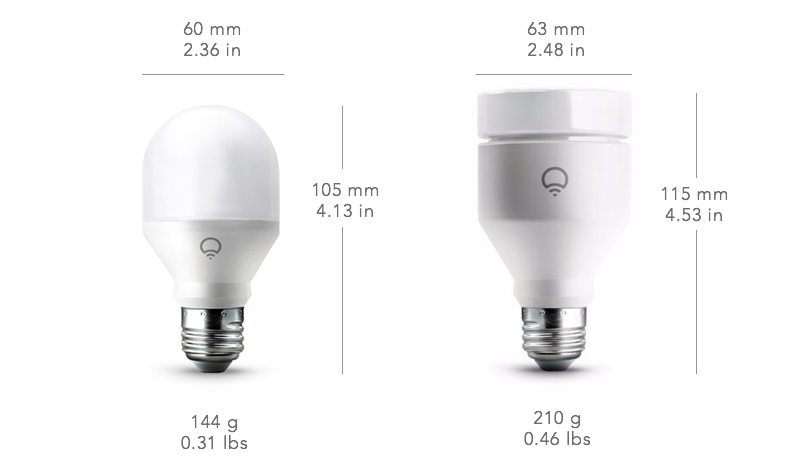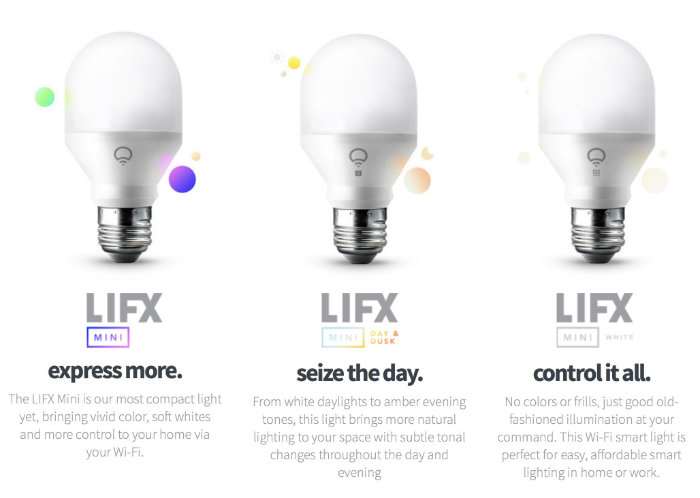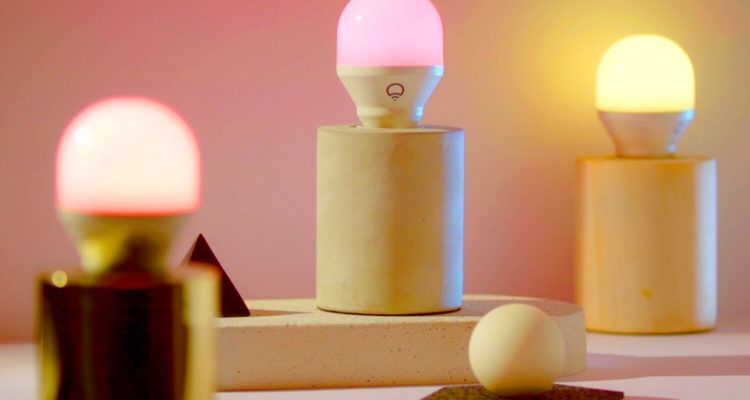As fans of LIFX bulbs, we have been excited for the release of the LIFX Mini A19 for some time. Previous models had shown great promise but unfortunately had some some minor issues that have held us at bay. This version however looks to address some design flaws and come in a more compact size. Perhaps most importantly, it’s their first bulb with Apple HomeKit support.
The LIFX Mini Smart LED Bulbs come in three different models. The standard version which is multi-color ($45), the LIFX Mini White ($25), and the LIFX Mini Day & Dusk ($30). This would be the lowest priced bulbs they have ever offered.
Better Design but Not Perfect
The standard LIFX Smart Bulb is plagued by a flat-top design that didn’t allow for a broad enough range of illumination. Thankfully the LIFX Mini has addressed that and features the more common globe design. This allows light to emanate from the top and sides of the bulb. But despite the improvements, it still doesn’t produce much light downward. This makes it ill-suited for reading lamps and other lighting apparatuses where you want a full 360 degree illumination from a bulb. I do however think it’s compact design makes it perfect for ceiling fixtures.

Lifx Mini vs Lifx 3rd Gen
Setup Requires Patience
Like previous LIFX bulbs, the LIFX Mini has it’s own Wi-Fi chip inside that allows it to work directly off your wireless network. First and foremost, you’ll need to install the LIFX app which is available on Android, iOS, and even Windows 10 (which is a pleasant surprise). The app guides you through the process. While the Android app uses the old method of connecting to the bulbs private network first and then connecting to your router, iOS users have it much easier. Being a HomeKit compatible product, the LIFX Mini will appear in your iPhone or iPad’s settings as a device that can connect to your existing Wi-Fi network. No need to go through the process in the LIFX app. Unfortunately, despite our hopes of it being able to run on 5GHz, it will only support 2.4GHz.
Connecting on iOS was incredibly easy and did so on the first try. It really feels like LIFX is tailor made for Apple users. Our Android device was unfortunately a bit frustrating. While the app could find the bulb easily, getting it to connect to our router required a number of attempts. All did eventually connect and we were prompted immediately with a firmware update. Firmware updates took about one minute per bulb to install.



App Offers Lots of Options
The LIFX app has made great strides since its inception years ago. It’s modern looking, feature rich, and still relatively simple to use. Connected lights will appear on your screen and can be renamed to fit your needs. Basic functions such as turning on and off the bulb and adjusting the brightness are right at your fingertips. For the multicolor LIFX Mini, you can cycle through what they claim are 16 million color choices in a convenient wheel. Preset colors and themes are also available. So are some fun “Effects” which allow the light to show off some fancy parlor tricks.
Scheduling your LIFX bulbs can be a bit of a grind at first but ends up working well once you learn the system. You can have lights scheduled individually or in groups. There are some innovative functions such as adding a fade duration for when it does turn on or off. This works great for those who’d like to use it as an alarm clock in a darker bedroom. You can have the light slowly brighten over the course of 30 minutes so that it mimics a sunrise. It’d be a fun way to let your kids know it is bedtime by having it fade out over a duration of time as well. With a little effort, you can customize your home to have the LIFX Mini act how you want them to, when you want them to.
Despite the improvements we’ve seen from the app, there are still some duds. A new option called “Day & Dusk” has been added that provides presets that mimic the natural progression of light throughout the day. For instance as your day progresses, you can have the bulb switch from a bright mode (whiter) in the day to a more subdued mode (more of an orange glow) in the evening. This is designed to help keep your circadian rhythm in check by flushing out the blue light as you get closer to bedtime. It finishes in a night mode which acts as a dull, orange nightlight. While this seems like a terrific addition, it feels a bit underdeveloped at this time. There is currently no option to change the color or brightness. You also can’t change the schedule on it for the weekend when you may be staying up later or sleeping in. Fortunately, LIFX has shown a history of improving features on their app over time.
One fun app feature we were interested to play with was the built-in music visualizer. The idea was that your lights would play along with the music. It appears to work by using the mic on your phone to pick up sound in the room. Unfortunately, it just didn’t work right. The lights didn’t seem to sync up at all to the music and there appeared to be considerable lag. There are however some third party apps that we’ve seen promising reviews on, but for now, you might as well forget this feature.
Bulbs Performed Admirably
One thing we’ve always respected about LIFX is they seem to use quality materials in their bulbs. The A19 Mini is no exception. Rated as a 60-watt equivalent (it only uses 9 watts), LIFX states the bulb will output 800 lumens. This appears true on it’s default setting, which is impressive for a compact bulb. Since each model is slightly different, we figured we’d breakdown their performance individually.

LIFX Mini – The standard model is a multicolor bulb that is both dimmable and tunable. Like previous iterations, this bulb produces rich colors across the spectrum. It’s one of the best quality color LED bulbs on the market and I’d even rank it ahead of the Hue when it comes to color.
LIFX Mini White – This LED bulb works as a 60W equivalent dimmable bulb that illuminates at a soft white temperature (2700K). The output was consistent and matched name brand 60W equivalent LED bulbs we’ve used before. It’s your standard dimmable light bulb with smart features attached.
LIFX Mini Day & Dusk – This is identical to the Mini White with the exception that it is tunable. This means you can adjust the color temperature of the bulb. It ranges from 1500K on up to 4000K. While we like the idea of this bulb, it doesn’t reach 5000K which are dubbed “daylight” bulbs. As someone who prefers the whiter light during the day (especially in an office), I was disappointed in that. While the bulb produced great light, we did notice the lumen output seemed to drop a bit when you got closer to the temperature extremes on both ends. It was unfortunately our least favorite bulb of the three.
It’s worth mentioning that these bulbs will not work on a dimmer switch. Dimming must be done either through the app or using voice controls.



Compatible With Almost Everything
With the addition of Apple HomeKit support, the LIFX Mini works with just about everything you could want. Google Home, Amazon Alexa, and Apple HomeKit offer voice controls and all worked relatively well once connected (the LIFX Mini requires a secondary skill through Alexa to change colors). You’ll be able to turn on/off, dim using percentages, and change the color using your voice (as long as the respected bulb offers that feature).
For non-voice controllable solutions, the Mini connects with the Logitech Pop, Logitech Harmony, Samsung SmartThings and even Flic. If security is your concern, you’ll be happy to see the lights sync with Nest and Scout Alarm. The Nest compatibility is particularly interesting as it can work with the Nest Learning Thermostat, Nest Cam, and Nest Protect. Solutions such as having the light turn red when motion is detected outside or having lights turn off on their own when you’re away from home can be enabled with a little work.
On the software side, LIFX has partnered with IFTTT to allow for connecting your lights to triggers and actions on Facebook, Uber, and Fitbit. Stringify provides a similar service and Sisense allows for the Mini to be synced into a business intelligence platform. For parents, the multicolor light will supposedly work with the Campfire app to make storytelling more engaging.
We weren’t able to test all the different solutions available, but it’s an impressive list. LIFX is arguably the most well-connected smart bulb on the market today. And with their aggressive approach to finding new partnerships, we expect to see more down the line.
Conclusion
While I still prefer Philips Hue if you’re willing to buy the bridge, LIFX has closed the gap a great deal. When it comes to Wi-Fi enabled bulbs that don’t require a hub, the LIFX Mini is currently the best available. The design has improved from previous LIFX offerings and the price has even come down a bit. Their compatibility is at the top of the industry and allows for some really innovative ways to implement in your home. There’s still some connection issues on the Mini, but they are for now just a minor annoyance that does seem to get better with each firmware update.
Overall, I’m still a bit torn on whether multi-color smart LED bulbs are worth the price. They’re certainly fun, but at just under $50, it’s an expensive way to replace a single bulb. I’ve been picky with their usage as I hope they come down in price a bit more. The Mini White however is a solid buy at $25. We’d however pass on the LIFX Mini Day & Dusk because the range of color temperatures is just not broad enough for us and the app doesn’t handle this function well. Overall though, this is a great set of bulbs that doesn’t require a hub and has some of the best compatibility you’ll find. We think you’ll be happy with purchasing one and they receive our recommendation.

